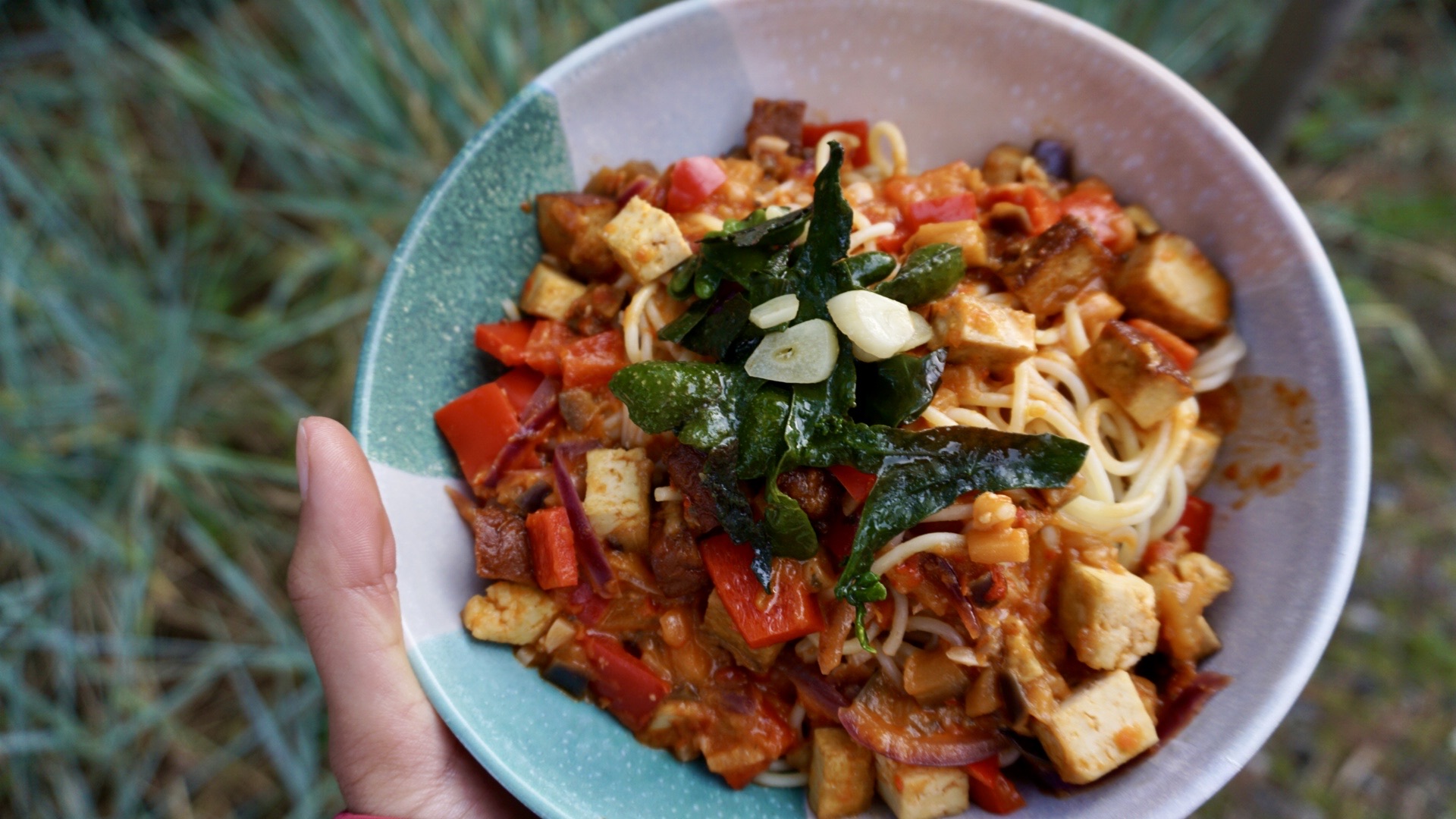I discovered Bladderwrack Algae by chance recently on a camping trip to the German North Sea. The North Sea, like the name suggests, is hardly tropical and reminds of hardy sailors in big wool sweaters. During the day, the tide goes for kilometers and leaves behind the bare seabed. Tourists ride horses across a strange landscape and sea gulls shriek. When the tide comes back in, it brings back the animals and plants of the sea each day. The North Sea is a great place to forage for all that the sea has to offer!
Why eat an obscure algae that you’ve never heard of?
We now use words like superfood to describe nutrient dense foods such as bladderwrack, but their use dates back to times when local peoples depended on these foods for a balanced diet and health. While you can easily reap the nutritional benefits of bladderwrack algae by taking a supplement, it’s a great way to add fibre into your diet and explore a new food.

The nutritional value of bladderwrack algae
Bladderwrack algae has an unflattering name, but it really does pack a punch nutritionally! Scientifically known as Fucus vesiculosus, it is a nutrient-dense seaweed renowned for its rich iodine content, making it beneficial for thyroid health. Additionally, it contains a variety of vitamins, including vitamins A, C, E, and several B-complex vitamins, which contribute to its antioxidant properties.
Bladderwrack is also a good source of minerals such as calcium, magnesium, potassium, and zinc, which are essential for maintaining healthy bodily functions. Furthermore, it provides a significant amount of dietary fiber, which supports digestive health. The presence of bioactive compounds like fucoidans and phlorotannins in bladderwrack has been linked to anti-inflammatory and immune-boosting effects, making it a valuable addition to a balanced diet.
Bladderwrack algae as part of a balanced diet for women
Its rich iodine content supports thyroid health, crucial for regulating hormones and energy levels in women. Bladderwrack’s high levels of calcium and magnesium are essential for bone health, particularly beneficial post-menopause.
How bladderwrack algae was traditionally used
While the Japanese have perfected the use of algae as a condiment and staple ingredient in their cuisine, bladderwrack algae has a rich history of use in various coastal cultures. In Europe, particularly in the British Isles, bladderwrack has been a staple in traditional diets and herbal remedies for centuries.
For example, in Ireland and Scotland, it’s often added to soups and broths like the traditional Irish seaweed soup or Scottish seafood stews, providing a unique flavor and a boost of nutrients. Locals also dry it to use as a seasoning, sprinkling it over dishes for its health benefits.
Where you can find bladderwrack algae
Bladderwrack algae is a type of algae that is commonly found along the coastlines of the Atlantic and Pacific Oceans, particularly thriving in the cold, nutrient-rich waters of the Northern Hemisphere. It is abundant along the rocky shores of North America and Europe, especially in areas such as the coasts of the British Isles, the Baltic Sea, and the eastern coast of Canada and the United States. Bladderwrack can also be found in tidal pools and attached to submerged rocks, often in regions where the tidal range is significant. This hardy seaweed adapts well to the fluctuating conditions of the intertidal zone, where it is exposed to both air and water, allowing it to flourish in diverse marine environments.

What to watch out for when foraging
As always, when foraging for food, be sure to be cautious about where and when you forage. Make sure, that foraging is allowed in the area that you are in. National parks and protected areas usually have much stricter guidelines. Please check before you decide to forage and check with local authorities if you are unsure.
Food safety while foraging
When foraging, you are responsible for making sure that the food you forage is safe, unspoiled and edible. Always err on the side of caution and discard anything that you are unsure about it.
Make sure you’re foraging for the right thing
If you can, for the first few times, find a local or experienced forager who can teach you what to look for and how to identify the right plant species you are looking for. Sometimes a species might look similar but not be edible.
Only harvest fresh ingredients
It is also important, to forage for fresh ingredients. With algae, this means foraging for algae that are still in the water and not washed ashore. Algae that are washed ashore are fed on by insects and other animals and are in the process of decomposition. For health and safety reasons, it is advisable to skip foraging washed up algae.
Forage in remote places
Algae that are washed onto the beach are also prone to being contaminated by dog or other animal faeces that might carry diseases. This is why foraging is best done in remote areas that are not subject to a lot of pollutants or waste products.
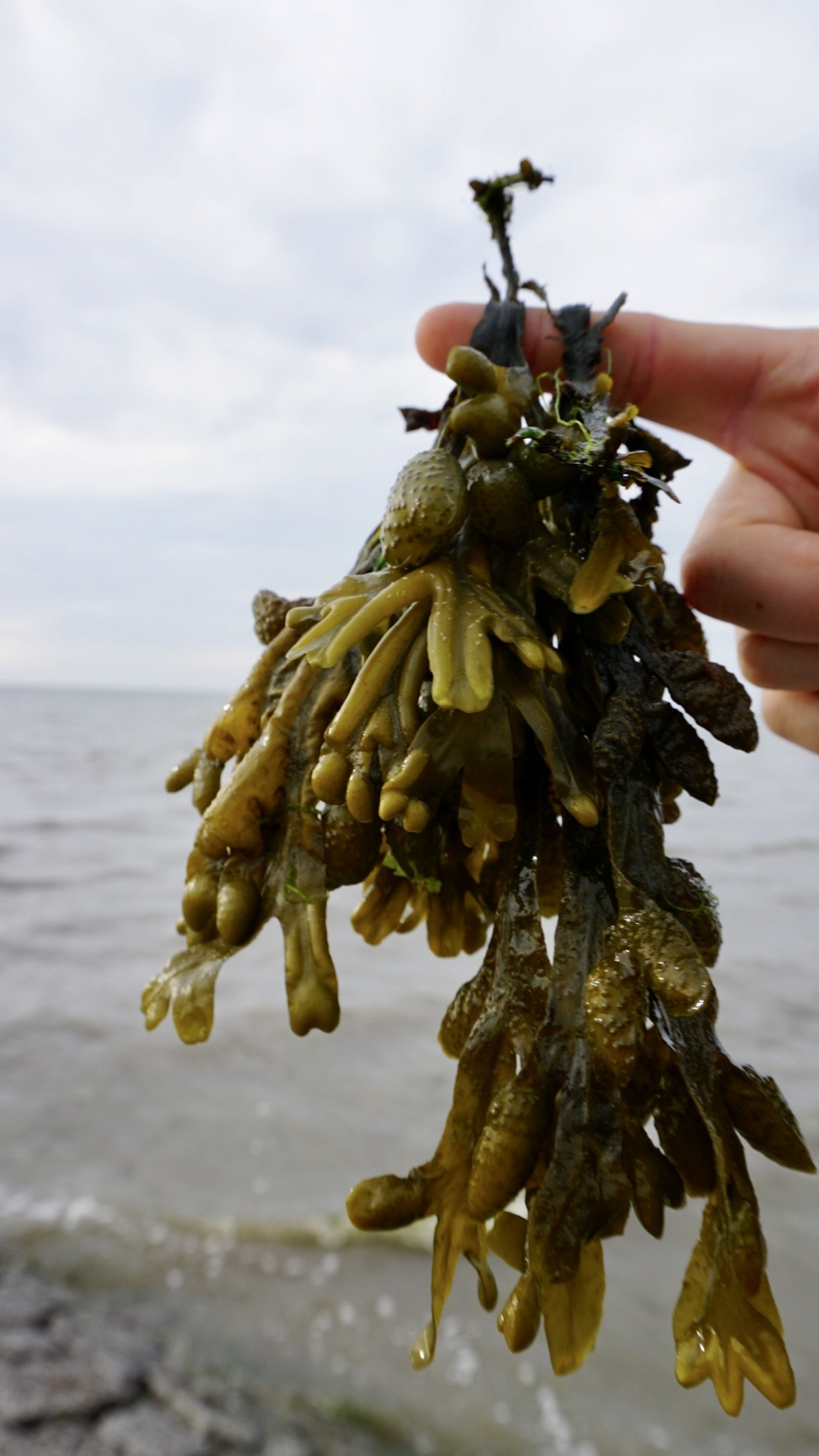
Be extra sure to prepare foraged ingredients well
When consuming foraged ingredients, I like to make extra sure that I won’t be consuming raw or half-cooked food. This is why this recipe cooks and then fries the algae.
How to cook with bladderwrack algae
Bladderwrack is an ingredient that accompanies proteins and carbs. Think of it more like a topping or a condiment rather than the centerpiece of your meal. It works well when it’s added to a dish.
What bladderwrack algae tastes like
Like other products of the sea, bladderwrack is imbued with the salty unmistakeable taste of the ocean. Surprisingly, the algae itself doesn’t have a strong taste. Even the ocean taste seems to step into the background, when the algae is paired with other ingredients. This makes it a great nutritional supplement.
As you might suspect from an algae, bladderwrack has a glibbery, slick, mouthfeel and tastes chewy when you eat it. Each bunch of algae has smaller bunches at the end of each strand, which are filled with a gelatinous substance. This part of the algae doesn’t have a different taste, just a different texture.
If you grew up in Europe or North America, chances are you will take a while to enjoy this kind of texture. If you dislike gelatinous, slick or slippery textures, I would advise you to leave out the little bunches at the end of the algae and only eat the “weedy” bit. I would also advise you to cut the algae into very small pieces, this makes the texture almost undetectable in the finished dish.
How to pair this recipe
This recipe is so filling that you do not necessarily need a side dish. If you do have a large group of people to feed, consider cutting up some fresh sourdough bread to satiate your guests.
A great accompaniment for this dish is a fresh zingy salad or a hearty fruit salad in summer. If you’re making this dish in winter, a hot broth would work well to accompany this pasta dish.
Tips and Lessons
If you’re eating this dish because you have an adventurous palate, I suggest cutting algae into bite sized pieces so that you can actually taste and enjoy it.
If you’re making this dish because of the nutrients, cut the algae as small as possible and mix it in with the other ingredients, you’ll hardly taste the algae if it’s cut up into small pieces. Regardless of how small you cut the algae, you’ll still reap the nutritional benefits of it.
If you’re in a rush, leave out the eggplant. This dish contains eggplant to boost the nutritional value of the pasta sauce and give it a bit more texture. Eggplant notoriously takes a while to cook or sautee and will make your dish taste bitter if you don’t give it the time it needs to cook through. Rather than downgrading your dish by rushing I would leave out the eggplant if you’re in a hurry.
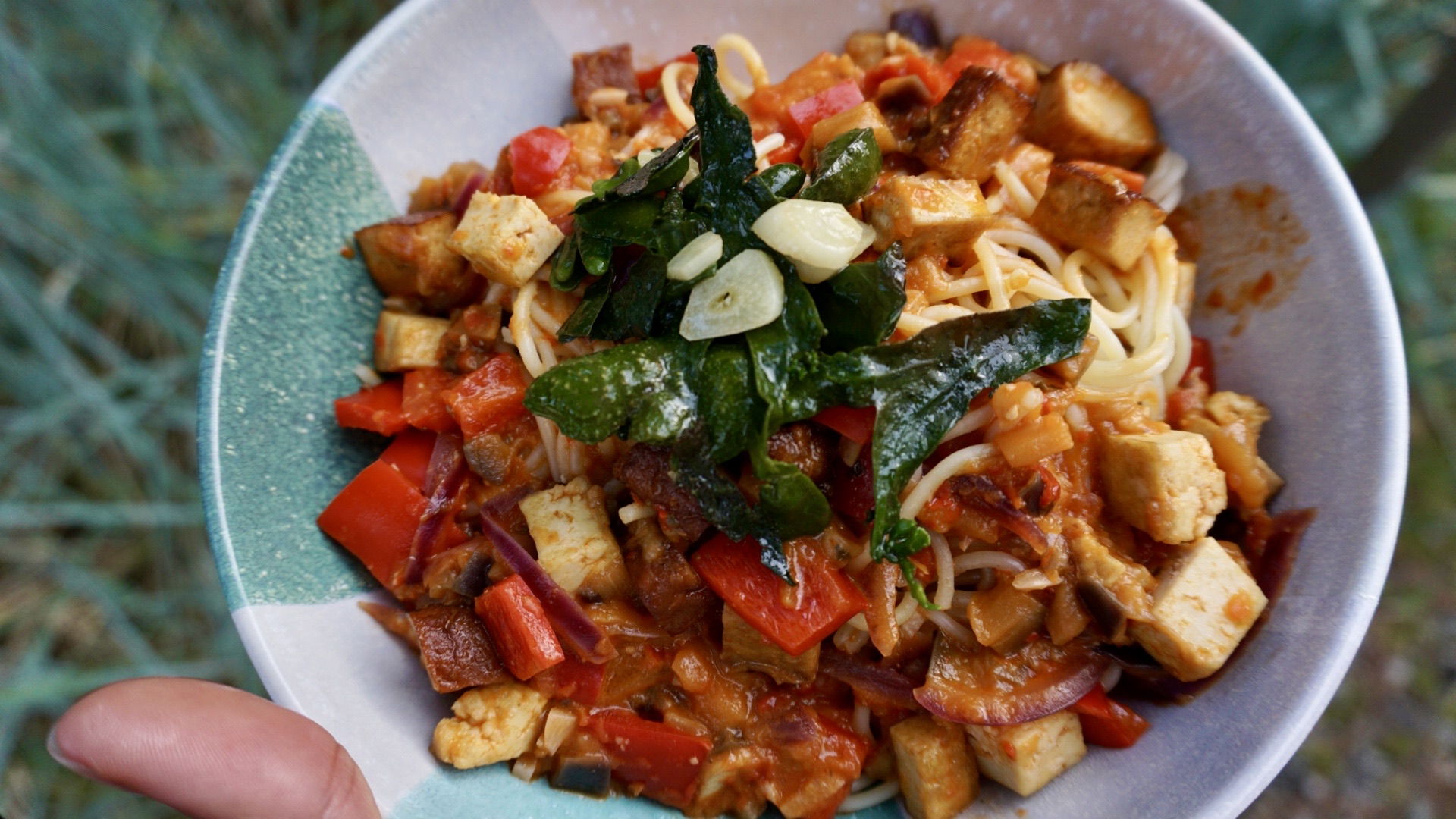
Swaps and Alternatives
If you don’t have bladderwrack algae on hand, this recipe works just as well as a simple pasta dish with minimal ingredients.
If you don’t have ajvar on hand, you can easily switch it out for ready-made pesto or a basic pasta sauce. This also goes for all the vegetables that I add into the pasta sauce. The veggies give the pasta sauce some bite and also add some fiber. If you’re in a pinch, leave out the veggies and go with your pasta sauce of choice.
Ingredients
- 1 pound of Spaghetti (approximatley 500g)
- 2 small cloves of Garlic
- 1 Jar of Ajvar
- 2 Tablespoon of Olive Oil
- 2 handfuls of foraged Bladderwrack Algae
- Salt to taste
Optional Additions
- 1 Eggplant
- 1 Red Bell Pepper
- 1 Block of firm Tofu
- 1 Teaspoon of Red Pesto
Equipment you will need
- 1 large pot for boiling the pasta
- small pan for sautéing garlic and algae
- 1 medium sized pot for the pasta sauce
How to make Foraged Bladderwrack Algae with Pasta
Prepare the Pasta and Algae
- Heat a large pot of water and bring to a boil.
- Once the water is boiling, add in the pasta and generously add salt. Your pasta water should be as salty as the sea. Don’t skimp on the salt here.
- While the pasta is cooking wash the algae thoroughly under running water.
- Now add the algae as a whole to the boiling pasta water and cook for five minutes. You’ll immediately see the color of the algae change from a brown greenish to a bright green.
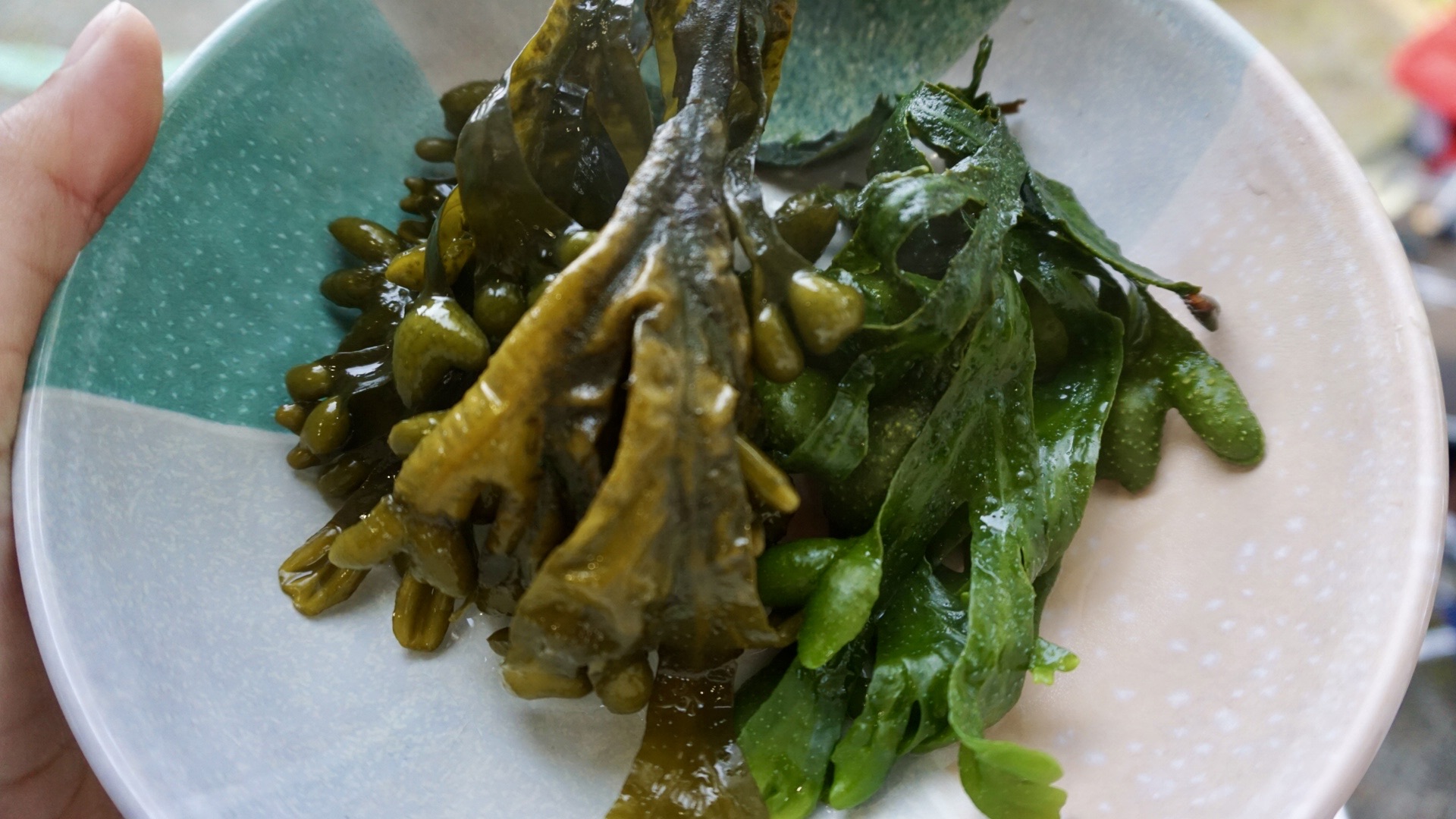
- Take out the algae and let cool until you can cut it into bite sized pieces. Put aside and keep.
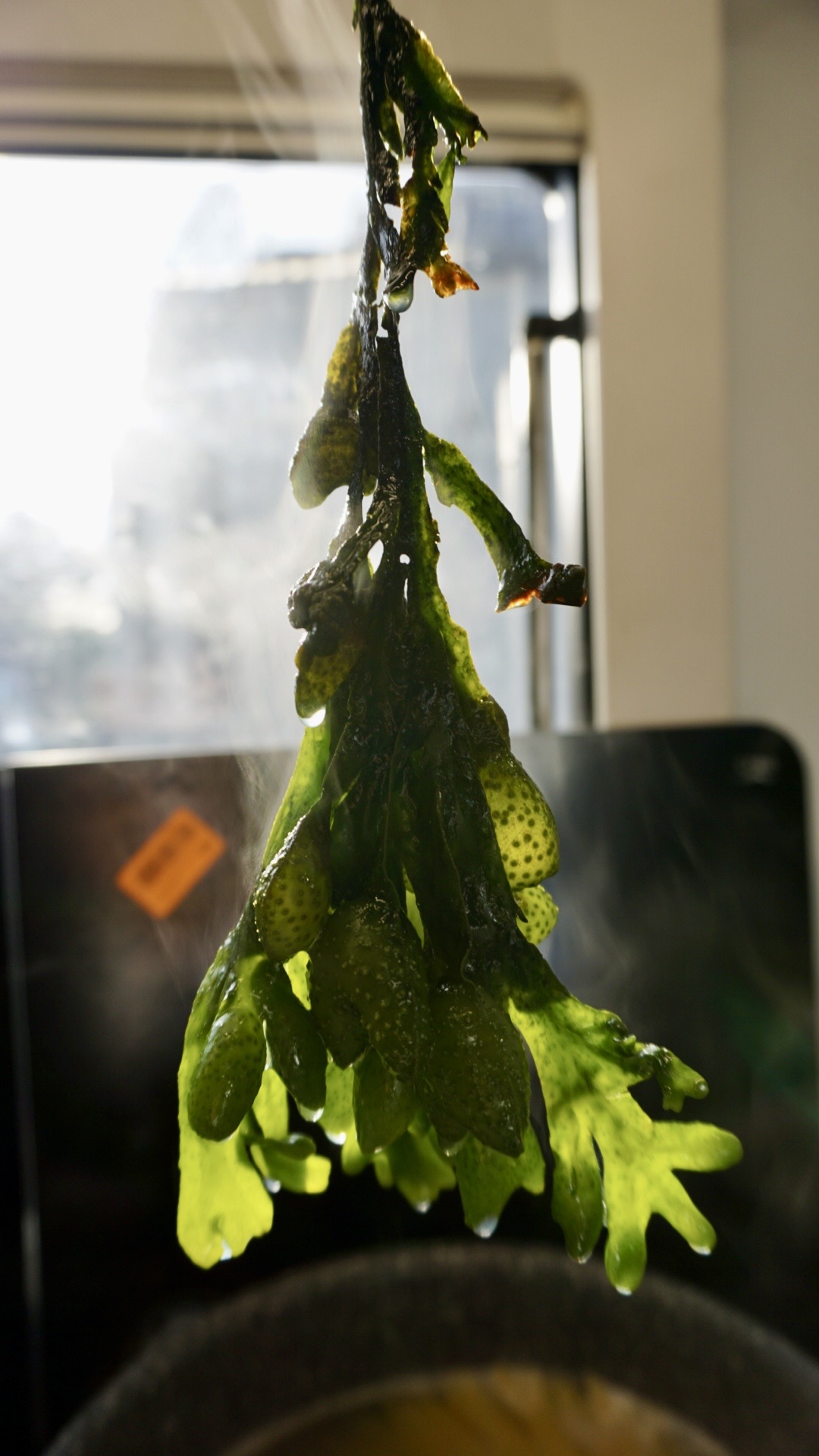
Prepare the Pasta sauce
- Cut up a block of firm tofu into small squares and add to a medium sized pot with a swig of olive oil. Turn up the heat to fry the tofu, so that the outside turns golden and crisps up a bit.
- While the tofu is frying, cut up an onion and one of the cloves of garlic. Add them to the tofu, once the tofu has had time to crisp up a bit. Let simmer and sauté until the onion and garlic are fragrant and translucent.
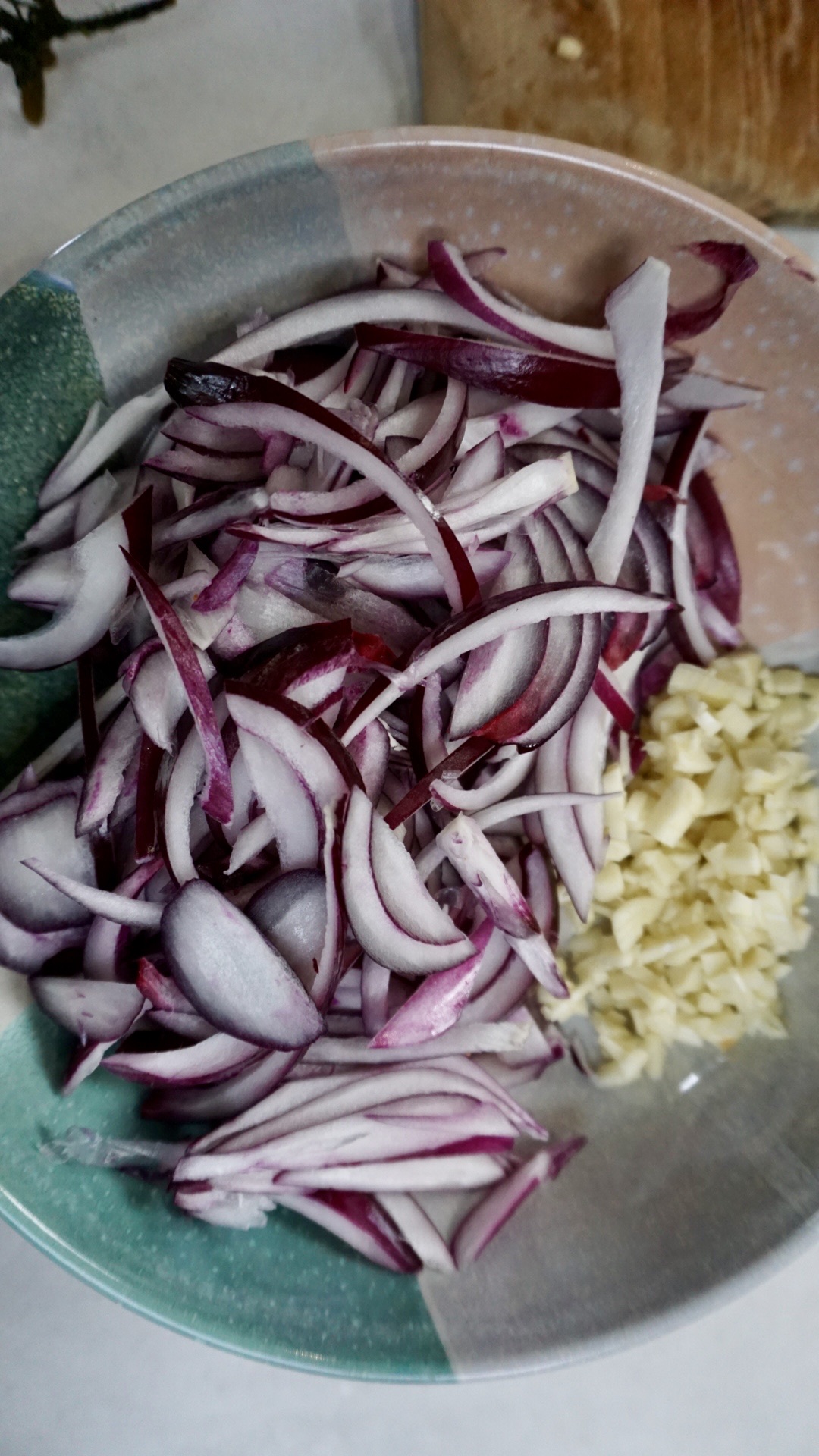
- Meanwhile cut up an eggplant into small square pieces. Cut these pieces as small as you can be bothered to. This will shorten the time you need to sautée the eggplant – the larger the pieces the longer the time it needs in the pan.
- Add the small pieces of eggplant to the medium-sized pot. Turn the heat down a bit and stir gently to make sure the eggplant doesn’t stick to the bottom of the pot.
- If you’ve cut the eggplant into small pieces it will turn soft and loose it’s whiteish color within a few minutes. The eggplant is ready when it turns almost translucent and exudes oil when you press on it with a laddle. Don’t add in other ingredients before the eggplant is ready. Raw eggplant has a chewy texture and a strange bitter taste that can really downgrade your dish. Give yourself the few extra minutes to make sure the eggplant is fully cooked through. If you’re in a rush, leave out the eggplant.
- Cut up the red bell peper into bite sized pieces and keep ready to add to the eggplant, onion, garlic and tofu once the eggplant is cooked through.
- Now add the whole jar of ajvar to the pot. Add a bit of water to the ajvar until the consistency is a bit more ‘saucey’. Now stir and heat over medium heat until almost cooking.
- Check the pasta and in case it is ready, siphon off a cup of the salty pasta water and then drain. Now set aside the drained pasta. If it’s not ready, keep an eye on it and keep it cooking on the stove.
Lightly fry the Bladderwrack Algae with Garlic
- While the ajvar is heating and the pasta is cooking, heat a tablespoon of olive oil in the small pan.
- Now mince a clove of garlic and add it to the warming oil until translucent and fragrant. Quickly, before the garlic begins to burn add in the cut up pieces of bladderwrack algae. Make sure the algae is tossed and turn up the heat, while tossing regularly to make sure the algae and garlic doesn’t burn. Once the bladderwrack algae is coated and heated through, take the pan off the heat.
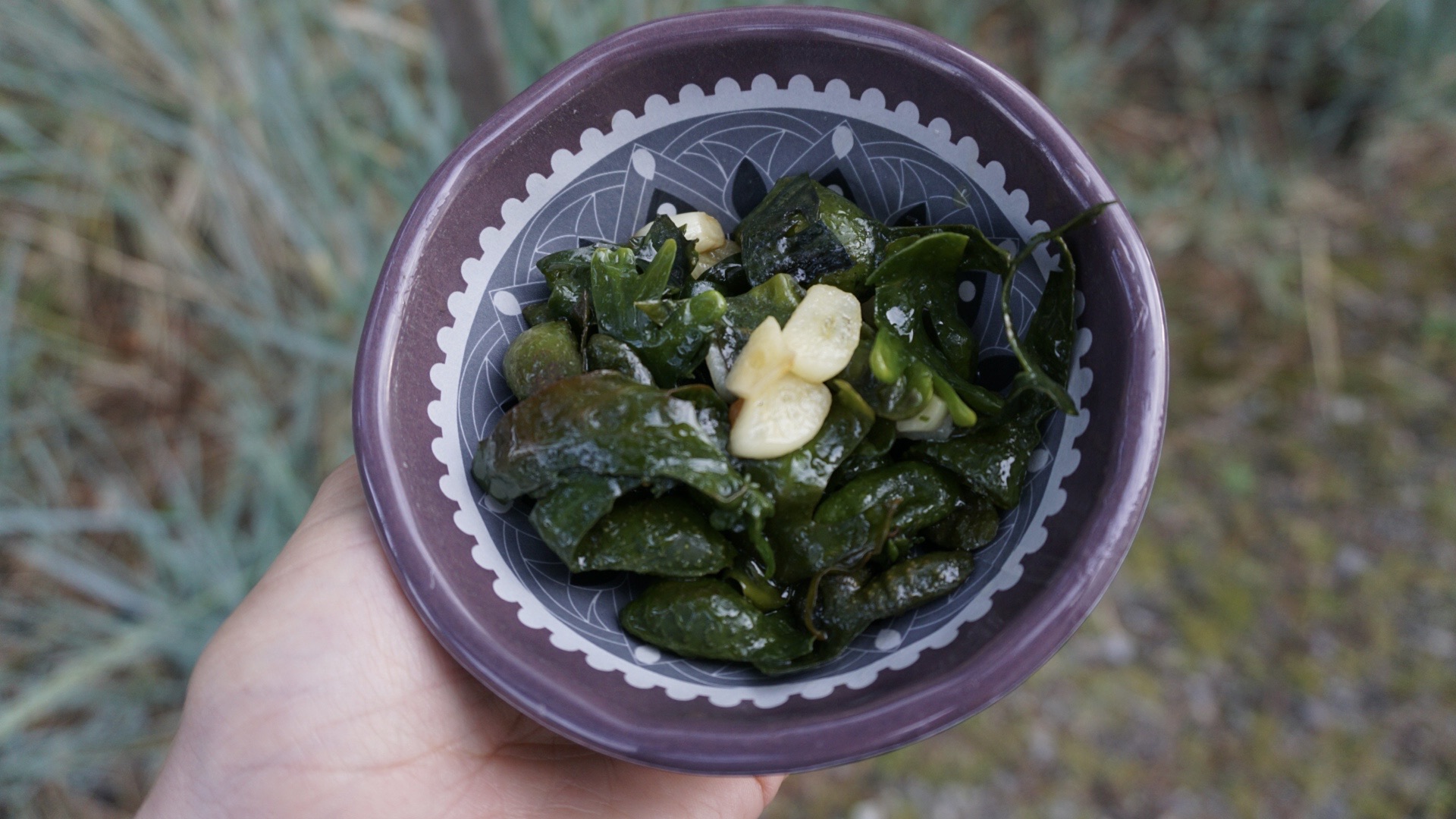
Finish off the Pasta sauce
- Now add a bit of the salty pasta water to the ajvar until you’ve reached the desired consistency. Add only a little bit, because the pasta water might be very salty. If you haven’t already throw out the remaining pasta water and add the pasta to the ajvar sauce. Mix well and serve on deep plates.
- Now top with the sated garlic algae pesto and serve hot. If you have picky eaters, mix the topping in with the ajvar sauce instead.
Have you cooked with bladderwrack algae? Let me know below!
Equipment
- 1 pound of Spaghetti (approximatley 500g)
- 2 small cloves of Garlic
- 1 Jar of Ajvar
- 2 Tablespoon of Olive Oil
- 2 handfuls of foraged Bladderwrack Algae
- Salt to taste
- Optional Additions
- 1 Eggplant
- 1 Red Bell Pepper
- 1 Block of firm Tofu
- 1 Teaspoon of Red Pesto
Ingredients
- 1 pound of Spaghetti approximatley 500g
- 2 cloves of Garlic
- 1 Jar of Ajvar
- 2 Tablespoon of Olive Oil
- 2 handfuls f foraged Bladderwrack Algae
- Salt to taste
Optional Additions
- 1 Eggplant
- 1 Red Bell Pepper
- 1 Block of Firm Tofu
- 1 Teaspoon of Red Pesto
Instructions
Prepare the Pasta and Algae
- Heat a large pot of water and bring to a boil.
- Once the water is boiling, add in the pasta and generously add salt. Your pasta water should be as salty as the sea. Don’t skimp on the salt here.
- While the pasta is cooking wash the algae thoroughly under running water.
- Now add the algae as a whole to the boiling pasta water and cook for five minutes. You’ll immediately see the color of the algae change from a brown greenish to a bright green.
- Take out the algae and let cool until you can cut it into bite sized pieces. Put aside and keep.
Prepare the Pasta Sauce
- Cut up a block of firm tofu into small squares and add to a medium sized pot with a swig of olive oil. Turn up the heat to fry the tofu, so that the outside turns golden and crisps up a bit.
- While the tofu is frying, cut up an onion and one of the cloves of garlic. Add them to the tofu, once the tofu has had time to crisp up a bit. Let simmer and sauté until the onion and garlic are fragrant and translucent.
- Meanwhile cut up an eggplant into small square pieces. Cut these pieces as small as you can be bothered to. This will shorten the time you need to sautée the eggplant – the larger the pieces the longer the time it needs in the pan.
- Add the small pieces of eggplant to the medium-sized pot. Turn the heat down a bit and stir gently to make sure the eggplant doesn’t stick to the bottom of the pot.
- If you’ve cut the eggplant into small pieces it will turn soft and loose it’s whiteish color within a few minutes. The eggplant is ready when it turns almost translucent and exudes oil when you press on it with a laddle. Don’t add in other ingredients before the eggplant is ready. Raw eggplant has a chewy texture and a strange bitter taste that can really downgrade your dish. Give yourself the few extra minutes to make sure the eggplant is fully cooked through. If you’re in a rush, leave out the eggplant.
- Cut up the red bell peper into bite sized pieces and keep ready to add to the eggplant, onion, garlic and tofu once the eggplant is cooked through.
- Now add the whole jar of ajvar to the pot. Add a bit of water to the ajvar until the consistency is a bit more ‘saucey’. Now stir and heat over medium heat until almost cooking.
- Check the pasta and in case it is ready, siphon off a cup of the salty pasta water and then drain. Now set aside the drained pasta. If it’s not ready, keep an eye on it and keep it cooking on the stove.
Lightly fry the Bladderwrack Algae with Garlic
- While the ajvar is heating and the pasta is cooking, heat a tablespoon of olive oil in the small pan.
- Now mince a clove of garlic and add it to the warming oil until translucent and fragrant. Quickly, before the garlic begins to burn add in the cut up pieces of bladderwrack algae. Make sure the algae is tossed and turn up the heat, while tossing regularly to make sure the algae and garlic doesn’t burn. Once the bladderwrack algae is coated and heated through, take the pan off the heat.
Finish off the Pasta sauce
- Now add a bit of the salty pasta water to the ajvar until you’ve reached the desired consistency. Add only a little bit, because the pasta water might be very salty. If you haven’t already throw out the remaining pasta water and add the pasta to the ajvar sauce. Mix well and serve on deep plates.
- Now top with the sated garlic algae pesto and serve hot. If you have picky eaters, mix the topping in with the ajvar sauce instead.
